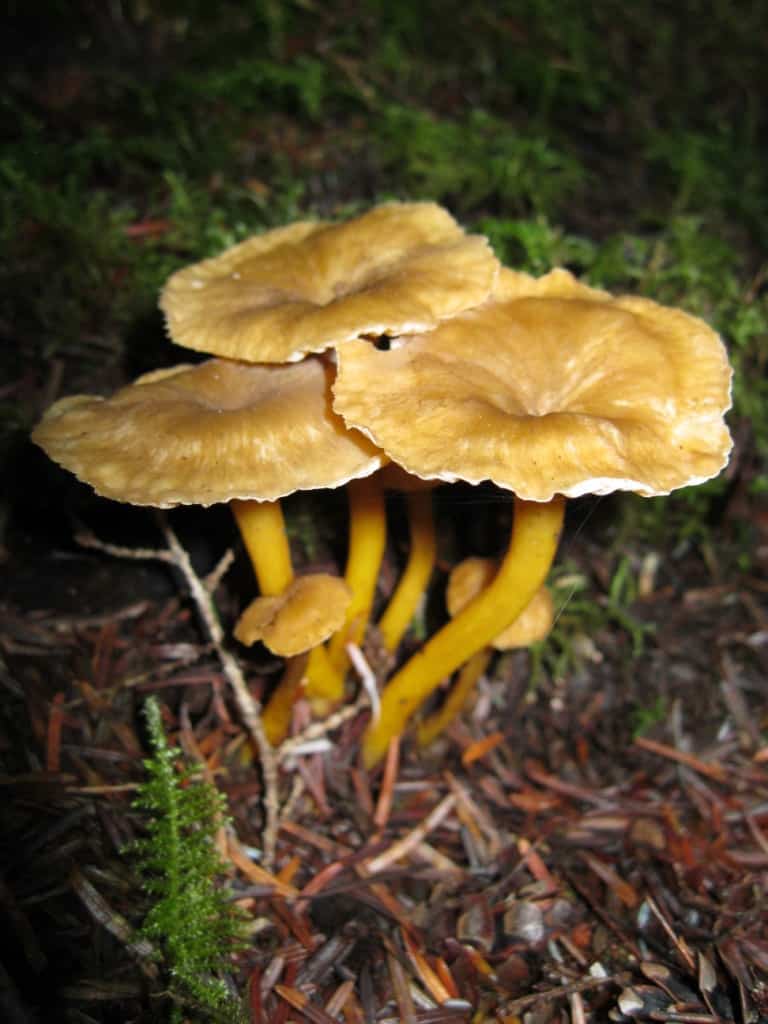Yellow Foot and Hedgehogs

Slim Pickings – Unlike the diversity of edible mushrooms available for picking in October, January offers up only a few hardy species in our area. Two of the most readily available are Craterellus tubaeformis, commonly known as the Winter Chanterelle or Yellowfoot and Hydnum umbilicatum, which we affectionately call the Bellybutton Hedgehog. Both mushroom species are considered good edibles especially given our limited options. Luckily, you can find them both in second growth conifer forests extending from the lower levels of the Cascade mountain range and continuing west to the Pacific coast. Of the two species, you are somewhat more likely to encounter the Yellowfoot mushroom. Preferring to fruit around areas with woody debris, stumps, large logs or needle duff makes their habitat fairly diverse but easy to identify. They typically emerge in good sized troops which can be scattered over a fairly large area. Their cap color starts out as a light yellowish brown color becoming dull and darker with age. The cap can be several inches across and wavy along the margin. It also sports a small dimple in the center which unfortunately is great for harboring small debris. The stem is hollow and can extend to 4 or more inches in length and look flattened, grooved, curved or quite irregularly shaped as the mushroom continues to develop.

The gills are especially important to check since they differ from true gills by being more blunted with crossing veins. They are also decurrent, continuing down the top portion of the stem. The flesh of the Yellowfoot, in my opinion, is a molecule or two away from being rubber. Waterlogged mushrooms can be squeezed in your hand and they will bounce back once released. The only mushroom similar enough to be of concern in our area is the Chrysomphalina chrysophylla. Pictured to the right are the underside of a single young Yellow foot and two of the look-alike Chrysomphalina chrysophylla. This species is smallish and has a more golden color than the Yellowfoot, although it too becomes more dull with age. The gills of Chrysomphalina chrysophylla are more bladelike than the Yellowfoot and brighter colored. While the edibility of the lookalike is unknown, it is not presumed to be toxic. In any event, as with any edible, be certain of the species you’re collecting.

While you can sit and sometimes pick dozens of Yellowfoot mushrooms in one spot, the Bellybutton Hedgehog is not so accommodating. However, since it contains many spines or teeth under its cap in place of gills, it is very easy to identify. The cap color ranges from creamy beige to creamy orange/peach. It likes the same terrain as the Yellowfoot but is also found in mossy areas as well. This species cap can become several inches across with a stem approaching 4 inches long that can be quite stout. The cap can be slightly irregularly shaped and also has a debris collecting dimple or bellybutton.

If you find specimens that are slightly waterlogged, do not apply the squeeze method to remove the water or you’ll be left with hedgehog mush as these tend to be quite brittle. You may need a hand lens to see the spines on newly emerging hedgehogs or better yet, come back in a week when they are larger. We typically find hedgehogs singularly or in small clusters. These patches can be spread out over a large area.
Whether you are trying to collect Yellowfoot or Hedghog mushrooms, be patient and try hunting at different elevations and in various geographical areas. Success is achieved only through persistence. And as we all know, there is no bad day in the woods.
References
Mushrooms of the Redwood Coast – Noah Siegel and Christian Schwarz





